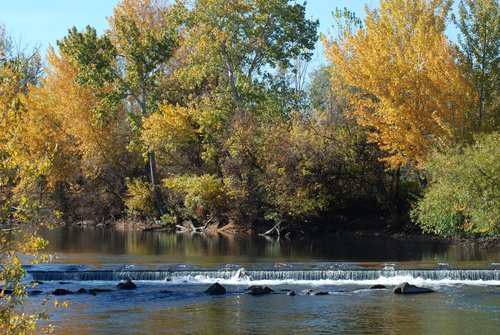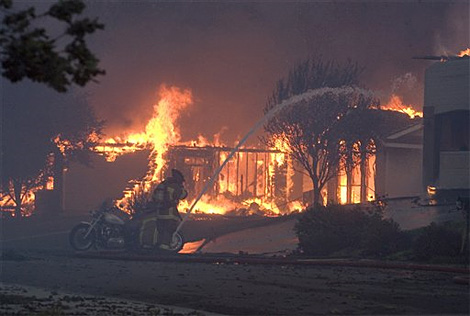For each overlay district that your property is in, you will work with multiple divisions throughout the building and development process. Building, current planning, engineering, and permitting all play a part in making sure all development is built in a safe and sustainable way. Our staff looks forward to working with you and with each other to ensure all Ada County residents can maintain the quality of life and level of safety we are so proud of.
Floodplain
In June, 2020, Ada County adopted the new FEMA Flood Insurance Rate Maps. You can use the tools below to look up what changes have been made near your property.
FEMA FIRMs Changes Map (with this map you can create a side by side comparison of the old and new maps)
If you have any questions about these changes, please feel free to reach out to Zach Kirk.
What is a floodplain?
A floodplain is an area adjacent to a river, creek, lake, stream or other waterways that is subject to flooding when there is a significant run-off event.
The technical definition of a floodplain as it pertains to the development process can be found in Ada County Ordinance 835.
What do I need to do if my property is in a floodplain?
Any development within the Floodplain will require a Floodplain Development Permit.
If you are considering development within a Floodplain, please view the entire Flood Hazard Overlay District Ordinance. You will need to fill out the floodplain Submittal Checklist along with a Master Application. If you have any questions, please feel free to contact the Ada County Engineer, Zach, at 208-287-7925.

Frequently Asked Questions
How do I determine if my property is within a floodplain or floodway?
Floodplain and floodway areas are designated by FEMA on the Flood Insurance Rate Maps (FIRMS). You can search the flood maps in your area using FEMA’s Map Service Center, or contact our office to determine if your property is within a floodplain or floodway. You can also view IDWR’s digital flood hazard interactive maps.
There are areas of Ada County with possible but undetermined flood hazards where flood hazard analyses have not been conducted.
If you are unsure as to whether your property is located in a floodplain or floodway, please contact our office.
What is the difference between the floodplain and floodway?
The floodplain is an area that is susceptible to being inundated by water from any source. Mostly, this is the area adjacent to a river, creek, lake, stream, or other waterways that is subject to flooding when there is a significant run-off event.
The floodway is the channel of a river or other watercourse that carries the deepest, fastest water downstream.
The technical definition of a floodplain as it pertains to the development process can be found in the Ada County Zoning Ordinance: 8-3F.
Can I build in the floodplain or floodway?
Before you start work in the floodplain or floodway including grading, excavation or filling, you must apply for and receive initial approval of a floodplain development permit from Ada County.
Other agencies may also require permits. It is the responsibility of the owner to obtain necessary permits before applying for a permit with Ada County. Other agencies include but are not limited to: Idaho Department of Water Resources, U.S. Army Corps of Engineers and Idaho Department of Lands.
Are there special requirements in the floodplain or floodway?
Yes. Within the floodplain, structures, including basements and crawlspaces, are required to be elevated above the base flood elevation.
Within the floodway, it is very difficult to conduct any work because a registered professional engineer licensed in the state of Idaho must determine that the work will not cause an increase in flood elevation to the waterway.
For more information, see the Ada County Zoning Ordinance, 8-3F.
What is Base Flood Elevation?
The base flood elevation is the level of floodwater expected to occur once in a hundred years. Generally, when constructing in the floodplain this is the elevation that the lowest floor of the structure, including basements and crawlspaces, must remain at least one foot above. For the technical definition as it pertains to development within the floodplain, see the Ada County Zoning Ordinance: 8-3F-4.
What are the types of areas within FEMA's flood insurance rate maps (FIRMS)?
Flood zones are the geographic areas that FEMA has defined according to varying levels of flood risk. The following chart gives a brief description of the zones that are present in Ada County.
| Zone | Description |
| X | Areas outside of the 1-percent annual chance floodplain |
| A | Areas susceptible to flooding, but detailed elevations and hydrologic calculations are not available. The Ada County Zoning Ordinance requires the owner to provide base flood elevation data for the site, prepared by a professional engineer licensed in the state of Idaho, with the submittal of a floodplain development application. See 8-3 F-3-3 for more information |
| AE, A1-A30 | Areas with a 1-percent annual chance of flooding. Base flood elevations derived from detailed analyses are shown at selected intervals within these zones |
| AH | Areas with a 1-percent annual chance of shallow flooding, usually in the form of a pond, with an average depth ranging from 1 to 3 feet. Average flood depths are shown within this zone |
| AO | River or stream flood hazard areas, and areas with a 1-percent or greater annual chance of shallow flooding, usually in the form of sheet flow, with an average depth ranging from 1 to 3 feet. Average flood depths are shown within this zone |
| D | Areas with possible but undetermined flood hazards. No flood hazard analyses have been conducted |
How can I help maintain the floodplain on my property?
Maintaining the flow capacity in streams that cross county properties requires cooperation and assistance to prevent flooding and bank erosion.
Do not dump or throw anything into ditches or streams: Trash and vegetation dumped into a stream degrade water quality and every piece of trash contributes to flooding.
Report Violations: Report any observations of dumping debris or vegetation clearing within the floodplain to Ada County Code Enforcement at (208) 287-5716.
Permitting
How do I obtain a permit?
After obtaining permits required by other agencies, you must submit a floodplain development application and checklist with the appropriate fee and required plans and documentation to Ada County Development Services. The application includes a checklist that includes all required documentation and approval steps. The County Engineer will review your application for compliance with the Flood Hazard Overlay District ordinance.
Will I need to obtain permits from any other agencies?
The following agencies may require permits and offer a joint application process:
- Idaho Department of Water Resources
Contact Info: Western Regional Office (208) 334-2190 or [email protected] - U.S. Army Corps of Engineers
Contact Info: Boise Field Office (208) 345-2286 or [email protected] - Idaho Department of Lands
Contact Info: Southwest Supervisory Area Office (208) 334-3488 or [email protected]
Additional agencies may also require approvals or permits. These agencies may include but are not limited to Idaho Department of Environmental Quality and the Environmental Protection Agency.
What is the penalty if I don't obtain the proper permits?
Failure to obtain the proper permits before you begin work can result in enforcement action by Ada County and/or other agencies including at a minimum:
- Corrective action
- Monetary penalties
- Criminal indictments and imprisonment
Approval & Conditions
My permit has conditions of approval; what does that mean?
If your application is approved, you may complete the approved work based on meeting conditions of approval, as determined by the Ada County Engineer. These conditions may include submittal of elevation certificates for structures. In this case, a certificate of occupancy will not be issued by Ada County until the final elevation certificate is submitted to and approved by the Ada County Engineer. Failure to meet conditions of approval may result in your permit being revoked and enforcement action may become necessary by Ada County or other involved agencies.
Check your permit conditions carefully. Feel free to contact the County Engineer at (208) 287-7925 if you have any questions regarding your floodplain permit.
Can I get a building permit now?
You may apply for a building permit at the same time you apply for your floodplain development permit. However, your building permit will not be issued until the County Engineer has approved your floodplain permit.
Be sure to check your floodplain permit for any conditions of approval that will need to be addressed during the construction phase.
What is an elevation certificate?
An elevation certificate is a form created by FEMA that must be completed by a registered professional engineer or land surveyor licensed in the state of Idaho. The form is usually completed at least twice: once based on building plans and once again after construction and prior to issuing a certificate of occupancy. The completed certificate provides the necessary information to ensure the structure is elevated in accordance with the requirements.
What is no-rise certification?
When work is proposed in a floodway, a no-rise certificate with supporting documentation, which is prepared by a professional engineer who is licensed in the state of Idaho, is required. This certificate demonstrates that a proper engineering study has been conducted and verifies that the proposed work will not result in any rise in floodwaters during a flood event. The no-rise certificate is required to be submitted with your floodplain development application.
Wildland Urban Fire Interface
Is your property within the wildland-urban fire area?
Click here for a map
Wildfire – Are you prepared?

Hillside
If your property has slopes of 15% or greater, you will need to submit a Hillside Development Checklist with your application.
We’re on social media!
Follow along for code explanations, frequently asked questions, public hearing information, and more!


